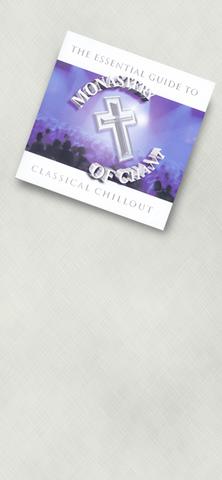What does the future hold for classical music? The question is raised by three new releases that span three possible answers. One sticks with the old-fashioned, traditional sound. The other two offer different compromises in the direction of a more popular appeal.
What we have in the latter two cases are commercial interests seeking to shift classical music, or bits of it, into the popular marketplace, either by vulgarizing it or by offering it as something that it's not. Accept this, the promoters appear to be saying, and you may have at least some of the young with you. Reject it, and your audiences will pass away as fashion unstoppably pushes the entire classical enterprise onto the garbage dump.
Is this true? Let's look at what's on offer and see.

ChloeP>
This is the traditional one. But because the solo violinist is only 15, it represents the claim that the old way is still best where the classics are concerned, whatever age you are. Chloe Hanslip is tastefully promoted, from the very title of the CD to the photo of her sitting cross-legged wearing patched jeans and trainers. But the music makes no concessions to what might be perceived as popular taste. The choice of items itself is unusual. Tchaikovsky and John Williams are probably the only instantly recognizable names. And several composers are included -- Niels Gade, Pablo de Saraste, Franz Waxman -- that even classical music enthusiasts may never have heard of.
The performances are excellent, as is the sound, and what is so marvelous is that this teenager's playing sounds emotionally mature as well as technically accomplished. This, then, is altogether a fine debut.

Naturally, exceptional musical talent in a child or adolescent is an extraordinary thing to contemplate. How does nature come up with such phenomena? The truth is perhaps that it comes up with miracles over and over again on a daily basis, but it's only in such things as chess, mathematics and music that most of us recognize it.
Filippa Giordano
What are we to say about Filippa Giordano? Is she a Maria Callas spin-off, an operatic parasite, or perhaps both? She's glamorous, she's sensuous, she breaks down into tears, and sobs again even as she wipes the tears away. She murmurs, she squeals, she gulps, she warbles. There's a moment in Puccini's Vissi d'arte when she even squeaks like a trapped mouse. She's dreadful and alluring at one and the same time. This is Sarah Brightman Italian-style, with an image half a lifetime younger. But Giordano knows how to make an impression, and many will no doubt be happy to adore her.

By using a microphone, she is able to be the sobbing little girl singing the big women's roles. But that she will appeal to emotionally adrift teenagers, and bring great classical moments in music to them for the first time, is certain. It's difficult, however much of a purist you may be, to disapprove entirely of the best tracks on this CD.
Most are famous operatic hits, though there are American popular numbers as well.
And even though the disc lapses badly after the first half, it's the artist's Italian quality that helps its overall success. Callas may well turn in her grave (though Giordano's talent is much closer to Madonna's), but it's the very fact that she doesn't have a big operatic voice that will allow her to charm a young audience.
Much of this CD will seem funny to some, but it will be fun to many more. At some points you don't know whether to laugh or cry, and simply end up doing both.
Monastery of chant
These two discs are a compilation of tracks taken from a variety of sources, all supposedly with a spiritual dimension. You have a great deal of genuine (if boring) monastic plainchant, the occasional 19th century classical choral item, and a number of contemporary ambient contributions as ill-defined as they are unmemorable. The reverse cover shows a barefoot and hooded monk reclining on a sofa.
What this product represents is not the modification of the classical tradition but the corporate packaging of items drawn from it. Whoever was responsible for its creation is not in the serious classical music business, and probably wouldn't claim to be.
These items are about as genuinely spiritual as the film of Lord of the Rings was genuinely Tolkien. If the items are not pastiche in the first place, they are made to seem so by their context.
Even so, it will probably find a following in Taiwan where, after all, there is a marked taste for kitsch, a willingness to give anything a try, and a cheerful acceptance of whatever commercial interests put on offer.
If these CDs had been grotesque or lugubrious, they might have been good for a laugh. As it is, their humorlessness is at the heart of what's wrong with them.
And as for their being what their title claims for them, they are in reality neither classical nor especially chilled-out, not a guide to anything, and most definitely not essential for anyone.
The real gem among these discs is therefore nature's prodigy, the 15-year-old violinist Chloe Hanslip. The Filippa Giordano CD is entertaining in its way, and Monastery of Chant unworthy of any serious consideration.

One of the biggest sore spots in Taiwan’s historical friendship with the US came in 1979 when US president Jimmy Carter broke off formal diplomatic relations with Taiwan’s Republic of China (ROC) government so that the US could establish relations with the People’s Republic of China (PRC). Taiwan’s derecognition came purely at China’s insistence, and the US took the deal. Retired American diplomat John Tkacik, who for almost decade surrounding that schism, from 1974 to 1982, worked in embassies in Taipei and Beijing and at the Taiwan Desk in Washington DC, recently argued in the Taipei Times that “President Carter’s derecognition

This year will go down in the history books. Taiwan faces enormous turmoil and uncertainty in the coming months. Which political parties are in a good position to handle big changes? All of the main parties are beset with challenges. Taking stock, this column examined the Taiwan People’s Party (TPP) (“Huang Kuo-chang’s choking the life out of the TPP,” May 28, page 12), the Democratic Progressive Party (DPP) (“Challenges amid choppy waters for the DPP,” June 14, page 12) and the Chinese Nationalist Party (KMT) (“KMT struggles to seize opportunities as ‘interesting times’ loom,” June 20, page 11). Times like these can

Dr. Y. Tony Yang, Associate Dean of Health Policy and Population Science at George Washington University, argued last week in a piece for the Taipei Times about former president Ma Ying-jeou (馬英九) leading a student delegation to the People’s Republic of China (PRC) that, “The real question is not whether Ma’s visit helps or hurts Taiwan — it is why Taiwan lacks a sophisticated, multi-track approach to one of the most complex geopolitical relationships in the world” (“Ma’s Visit, DPP’s Blind Spot,” June 18, page 8). Yang contends that the Democratic Progressive Party (DPP) has a blind spot: “By treating any

You can tell a lot about a generation from the contents of their cool box: nowadays the barbecue ice bucket is likely to be filled with hard seltzers, non-alcoholic beers and fluorescent BuzzBallz — a particular favorite among Gen Z. Two decades ago, it was WKD, Bacardi Breezers and the odd Smirnoff Ice bobbing in a puddle of melted ice. And while nostalgia may have brought back some alcopops, the new wave of ready-to-drink (RTD) options look and taste noticeably different. It is not just the drinks that have changed, but drinking habits too, driven in part by more health-conscious consumers and